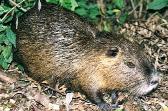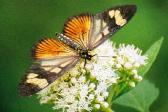What
is there to see at the Ribera Norte nature reserve?
THERE ARE PLANTS...
Ribera Norte is a wild place. Here the plants grow as they wish, without
a gardener to care for them. There is a great diversity of species including
water plants, herbs, lianas, palms, ferns and trees. Some species grow
in colonies associated with others to form special habitats, such as
reedbeds, willow forests, etc.
AND ANIMALS...
Plants attract and provide shelter to many species of animals that roam
freely. There are many insects: butterflies, dragonflies, beetles, etc.
There is a fine diversity of birds, ranging from the tiniest hummingbirds
to large herons and even raptors. There are reptiles, amphibians, mammals,
molluscs... All sorts of creatures.
AND THERE'S A TRAIL
Measuring about 1,200 meters it winds through various habitats encircling
the central area of the reserve . On your way you'll be able to see
this living collection of flora and fauna. What species you see will
depend on the time of day, the season, the weather, and much also depends
on you: your skill and patience, your ability to spot animals that are
sometimes small or well camouflaged, and in particular the attention
you pay to what your ears are sensing.
Most of the living creatures here are native.
That is, they belong to this part of the world - it is part of the natural
range of these species. But there are also some foreigners: exotic
plants and animas that come from other parts of the world, introduced
by man since American continent was discovered, and still happening
at an ever-increasing rate. (Globalization is alive and well in this
respect!). Exotics are printed in red as they are often a serious threat
to native species. Not having their "home enemies" to feed
upon them, they sometimes thrive and expand totally out of control.
And when the displaced species is a plant, this implies that the animals
that live off it will also vanish. So as you see, many dependencies
occur among wildlife. Allowing an exotic species to "take hold"
in another land can lead to extinction.
You
can find the national flower and bird of Argentina in Ribera Norte
Ceibo
(o Seibo) - National Flower
Erythrina crista-galli
In guaraní language: Zuinandí
Flowers from beginning of November till nearly Mayo
|
Rufous
Hornero - National Bird (in nest)
Furnarius rufus
In Spanish: Hornero
You can see it here all year round
|

|

|
PLANTS
Though most are native, few if any are known by the average city dweller.
Save for some exceptions, local plants seldom show up in our culture.
They are hardly ever used in gardens or parks, and until recently had
little mention in school textbooks. Florists snub them and most nurseries
have never heard of them. At such places European and other "perfected"
species steal the show. How then does one start to learn about them?
Who is there to remind us that many native plants are just as lovely
- if not more - than the exotics? Since they have been disregarded for
centuries and some are in serious decline, who is there to care about
their conservation? Clearly difficult questions to answer.
Some native tree species of Ribera Norte:
Willow
- Salix humboldtiana
Ceibo - Erythrina crista-galli
Aliso de Río - Tessaria integrifolia
Tala - Celtis Tala
There
are also many small herbs, locally known simply by the rather derogatory
term "yuyo" - which only helps to perpetuate the idea of them being
a rather useless undergrowth. But a visit to Ribera Norte in spring
or in summer should quickly dispel this! If you are after flowers you
will see just how lovely or "yuyos" can be. I like to point
out that these are also "plants in their own right - with a scientific
name and all". Treasures of the botanical world that only grow
in the special riverside habitats that Ribera Norte protects. If you're
interested, click HERE to see
a collection of photos of their flowers, mostly taken at Ribera Norte,
which demonstrates that Ribera Norte is a true "reservoir"
of botanical biodiversity. And THIS is the main reason why it must be
preserved. The attractiveness of the trail is but secondary!
Left:
A "yuyo" - or rather... Dicliptera tweediana - also
known as "Red Canary" (Canario Rojo)
Right: Another yuyo? No way! This is Oxalis macachin
ANIMALS
OK, you know it but I'll say it again: What does this vast diversity
of plants provide: Amongst other things it supports the fauna. Frogs,
insects, snakes, cavies, coipus and all sorts of birds. These animals
feed off them, take refuge and nest in them. The animals are here
simply because their favourite plants are here.
I have seen at Ribera Norte over 160 species of birds, including 3 kinds
of hummingbirds, seven different herons that include the gorgeous Rufescent
Tiger-Heron. What else? Grebes, ducks, shags, raptors, rails, gulls,
parrots, doves (also 4 different species), owls, woodpeckers and a wide
assortment of songbirds, some boasting fabulous colors.
That's
right: here in Acasusso there are you can see birds with brilliant red
plumage. If you've never seen a Vermilion Flycatcher or the Scarlet-headed
Blackbird, you'll have a hard time believing their colours are entirely
natural. And photos go nowhere near in doing them justice.
|
|
 |
 |
|
Left
to right::
A Chimango Caracara, a cavy, a butterfly (Actinote carysina)
and Apple Snail eggs (Pomacea sp.)
¡All here in Ribera Norte!
Now not every creature is here all year round nor all over the reserve.
Some migratory birds are only seen in summer, and other only in winter,
in July and August. Butterflies are more numerous at midday towards
the end of the summer. You may see bats only in the evening. Tortoises
only by water. Most birds are easier to see very early; others hide
in thickest rushes, or always stay high up in trees.
If you're interested in seeing more about the animals of Ribera Norte
you can explore other pages of this website.
|
|
|
Discovering
and spotting wildlife is quite a challenge. You certainly won't see all
on your first round, and there will always be things to search for on another
visit. Perhaps there was no Coipu swimming across the lagoon this time.
A lot depends on HOW we do the trail: either quickly as if wanting to leave
soon, or slowly, stopping here and there, waiting quietly in some spots
to give our good luck a better chance. Why not forget our daily hurries
and slow our pace to properly merge with nature for a while? A bird that
has been flushed may take a long while to creep out of hiding - maybe 5
or 10 long minutes. So if we want to see it, one very simple way might be
by just waiting for it, standing still and not moving. And during this time
who knows what other magical surprises will make our day...
These simple techniques greatly increase our chance of seeing animals. Also
pay great attention to the sounds, for these often betray the presence of
birds and other animals more easily than by seeing them move. The rest is
only luck: a bird of prey that by chance silently flies right above us,
or an animal that walks across the trail just a few meters away.
Well, I hope I have given you a few motives to make a visit. Make sure you
bring a guidebook of native plants, your binoculars, your camera, and a
guide to the birds of butterflies.
LEFT:
Surprise! A
harmless Tegu Lizard basks in the sun along the trail. They are seen mainly
in summer. They hibernate during the winter. |